Contents
- General information
- How to get to the island
- Rules to enter
- Traveling with a guide and tickets
- Self-guided traveling
- Moving around the island
- Prices and the local currency
- Recommended length of the stay
- Links elsewhere
General information
This guide is intended to be purely practical. It's not intended to repeat facts about the history, culture and sights of Easter Island that can be found anywhere on the internet, including Wikipedia. However, we spent many hours researching practical things before our trip. Some of them we only learned on the spot because they are not available online. There are also many out-of-date travel blogs which, as a result, give misleading information. So I want to write a text that I'd like to read myself before my trip. We visited Easter Island at the end of 2024.
Easter Island (Rapa Nui / Isla de Pascua) is located in the eastern part of Polynesia and 3,600 km west of the coast of Chile, which administers it. It has an area of 163 km² and is home to approximately 6,000 people, most of whom are Rapanui (indigenous people). The local time zone is GMT-6 and GMT-5 in summer (note that summer is a different time of year in the southern hemisphere than in the northern one).
Spanish and Rapanui are spoken. English proficiency is significantly higher among the islanders than in Chile, but Spanish is useful in some situations. In our case, Spanish was needed to deal with accommodation and also with car rental. I suppose if you rent a car from a large rental company and stay in a hotel, you can get by with English without any problem.
Due to its geographical location, the island has a rather slower internet connection with high latency. For normal communication or searching things online it's sufficient, but for example video calls work worse.
How to get to the island
The easiest and probably cheapest way is to fly with LATAM from Santiago de Chile. Specific prices vary a lot depending on the day and the time of year – they tend to be higher in the summer (December to February). One-way tickets (there or back) most often range in price from 350 to 500 USD, but on attractive dates can even reach 1000 USD. If you are flexible in terms of dates and length of your stay, a one-way ticket can be found for around USD 150. As is also the case with other LATAM flights, there is an extra charge for on-board luggage, so it's a good idea to consider how much you want to take with you. Planes fly to the island almost daily – there in the morning, then back to Santiago in the afternoon.
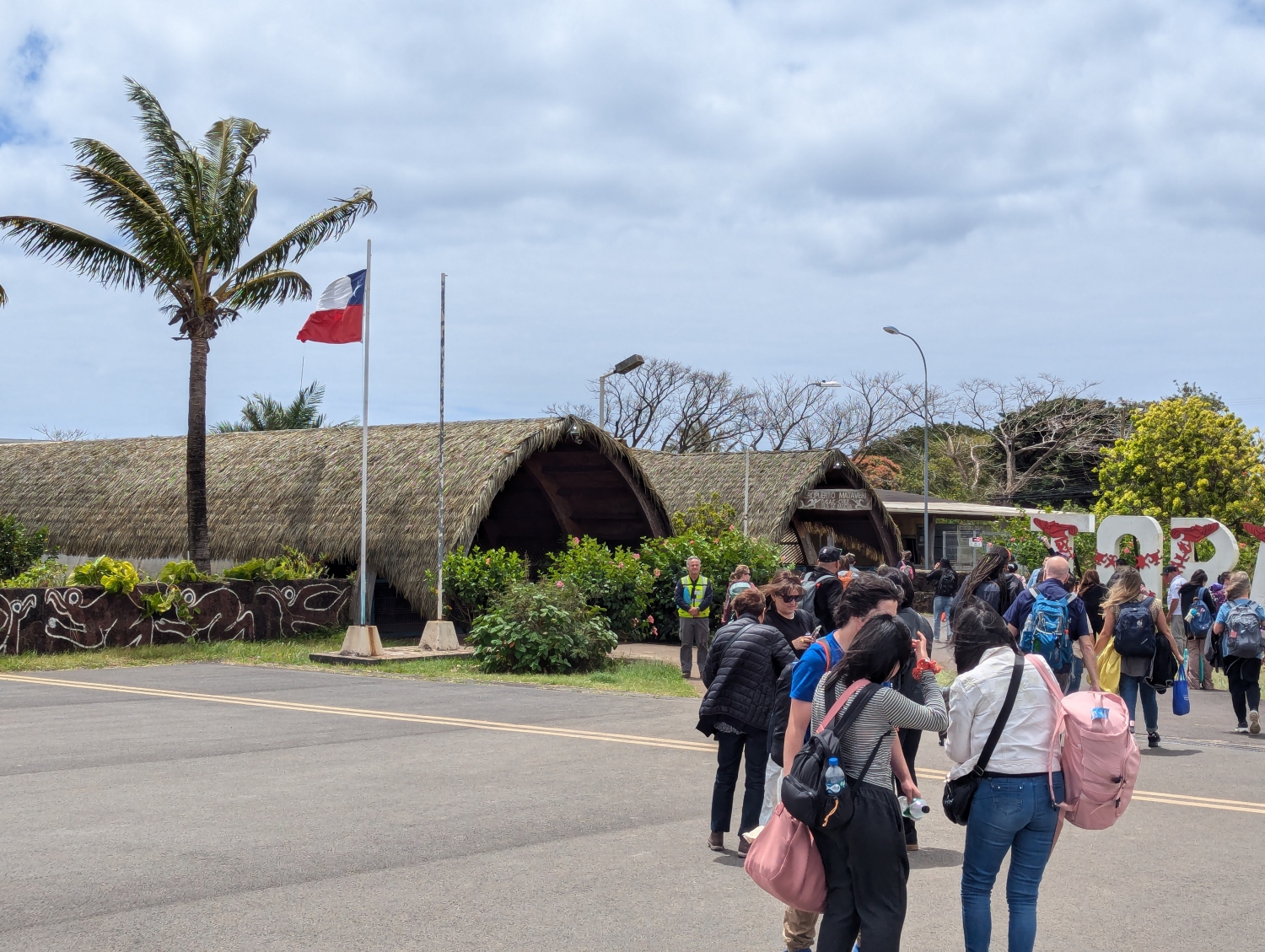
Airport in Hanga Roa
Reportedly there are cruises from Chile as well as from Australia and New Zealand. We have not explored these options further as it is very expensive. Some guidebooks still mention flights to Tahiti, but this service was cancelled about two years ago.
Rules to enter
Although the island is formally a part of Chile, there are a few extra rules that apply here compared to the mainland. At Santiago airport, passangers flying to Easter Island go through a process similar to a border control. In particular, the police check the pre-filled entry forms and the accuracy of the information provided on them. In addition to your personal data, the following are essential:
- the number and date of the flight to the island,
- the number and date of the return flight,
- accommodation for the duration of your stay.
It follows that it is necessary to have accommodation and a return ticket before departure. Please note that the accommodation must be officially registered. The length of the tourist stay must not exceed 30 days.
Traveling with a guide and tickets
Guide
Unfortunately, from 2023, it has been made compulsory to have an arranged guide for most of the sights. At the same time, it has to be stressed that this is not a person who is near the monument and can take the tour with you. The way this works is that you have to pay a guide for a period of time (typically a day or half) and they will visit the places you want with you. A list of certified guides can be found on the park's website. Everything is primarily communicated via WhatsApp.
During our trip, we had a guide for the whole day (about 8-9 hours) for a price of about 180 USD. According to our information, this is more of a lower price, usually it's said to be a bit more. If you want to save money, plan an one-day tour, it's enough for the major sights. It is important to find out if the guide will take their own car or if you will have to rent one. Often, though, the no-car option works out better. In fact, the rental fee may be more expensive than the extra the guide will charge you for their own vehicle. I write about car rental later in this text.
Alternatively, it is possible to buy a group bus tour. There are many options, just type it into a search engine. We didn't use this option during our trip because we found it expensive in the context of how many sights you visit during the tour. We've read on other travelers' blogs that it's sometimes possible to wait at the entrance to a monument and unobtrusively join another group that has a guide. We can't rate this option because we didn't get to do that anywhere.
Important places to visit are quite nicely shown on the map in the official park guide. You can also expect that the sights will be recommended by the guide you hire. However, be aware that the map also includes some places you can visit on your own – I've listed them below. During our visit to the island, we also encountered a situation where the guide initially planned to include sites in the tour that could actually be visited without them. I strongly recommend avoiding this, as hiring a guide is not cheap, and it's best to use their services for places that you wouldn't be able to access on your own.
If you have a guide, be sure not to miss Ahu Tongariki and Rano Raraku, which I rate as the best sights.
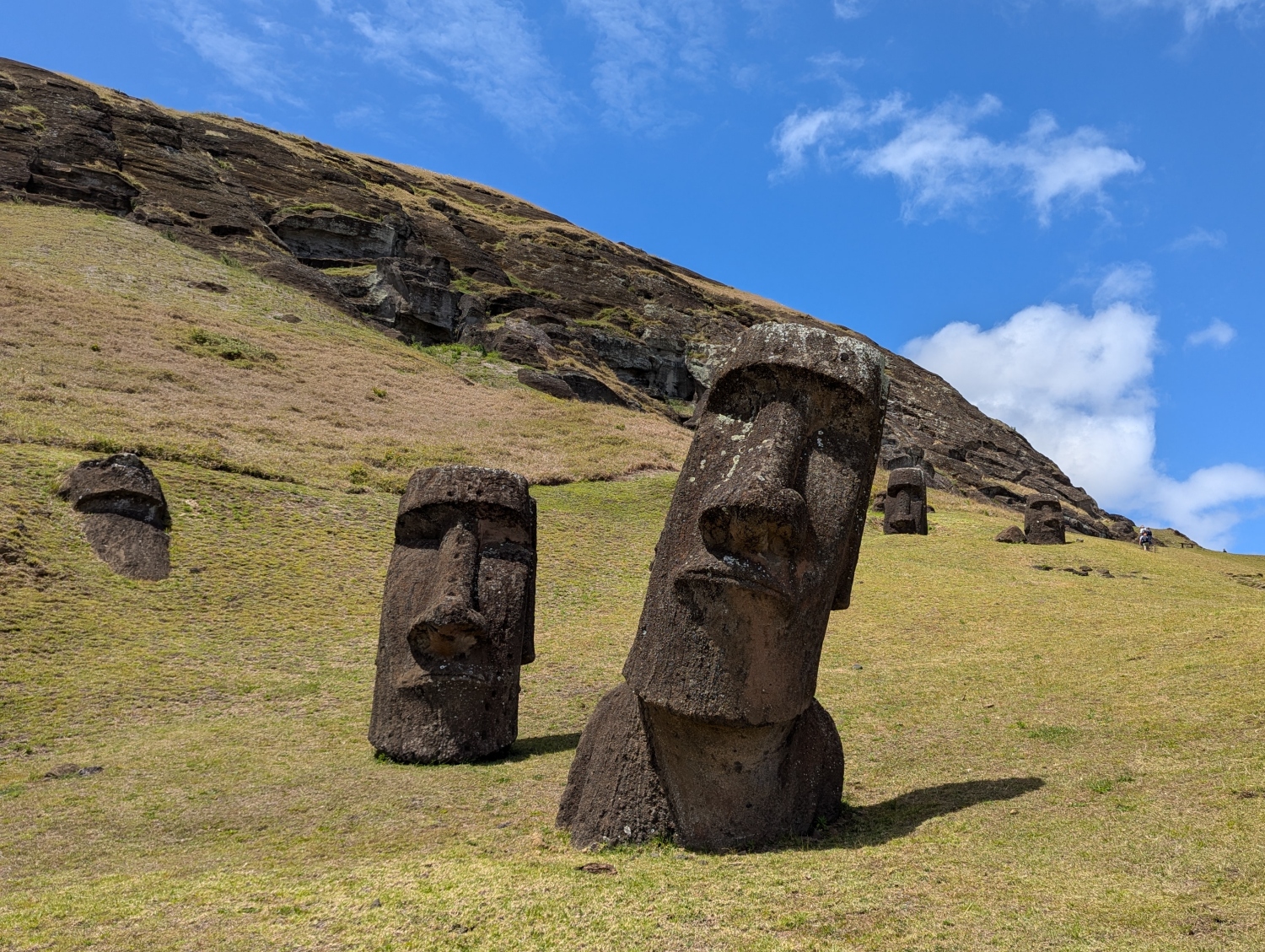
Rano Raraku
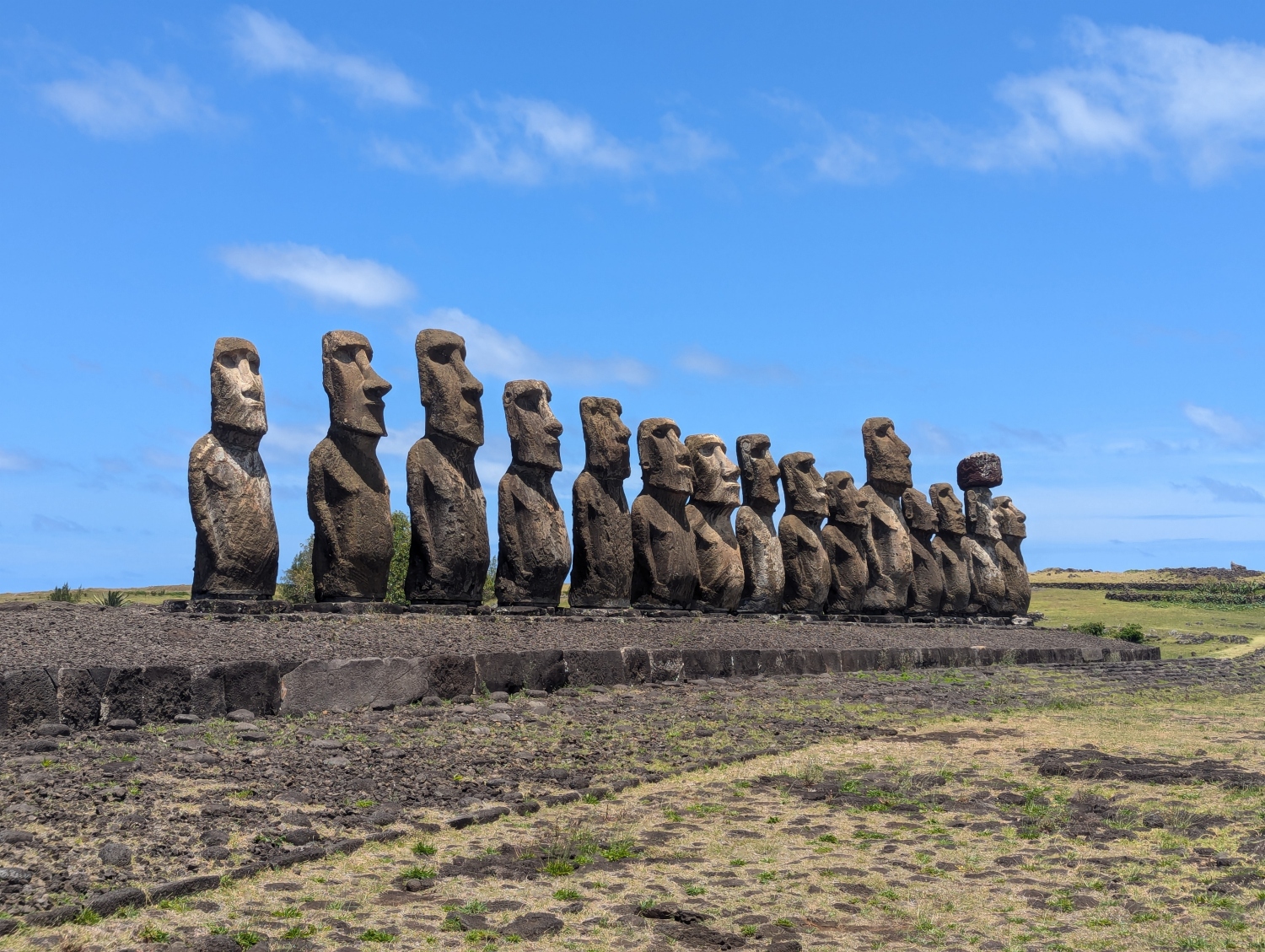
Ahu Tongariki
Tickets and entrace to the park
For most landmarks on the island, you need to have a valid entrance ticket, which can be purchased either online on the park's website, or in person at the office in Hanga Roa, the island's main town. The current price is 78 USD for adults and half that for children under twelve. Make sure to download or print your ticket to have it available offline, as some sites have poor or no cell signal.
The places that require a ticket are also the ones that must be visited with a guide. This means that if you don't want a guide, you likely don't need to buy a ticket either, as it would probably be of no use to you.
Self-guided traveling
There are relatively few places on the island that you can visit without a guide, and it's not easy to find out in advance how things work at each site. We compiled the following list based on a combination of information from the internet, locals, and our hired guide. Some places we discovered by chance along the way. We have visited all the locations listed, so we know for sure that it is possible to go there independently.
-
Town of Hanga Roa (-27.15014, -109.42694 | Map):
The island's main town, where you can swim at several spots, watch turtles swimming in the ocean, visit a small botanical garden, and try various water activities. -
Ahu Tahai (-27.13991, -109.42727 | Map):
Moai statues -
Ahu Ko Te Riku (-27.13907, -109.42712 | Map):
Moai statues -
Hanga Kioe (-27.13309, -109.42726 | Map):
Moai statues -
Ahu Riata (-27.15445, -109.43887 | Map):
Moai statues -
Ana Kai Tangata (-27.16110, -109.44179 | Map):
Cave in the sea and a reef -
Viewpoint at Rano Kau (-27.17946, -109.43899 | Map):
Lake in the crater of the volcano -
Ahu One Makihi (-27.13807, -109.28318 | Map):
One of the less preserved platforms with fallen statues. There are many similar ones along the road on the southern side of the island. I recommend driving the entire route, as no guide is needed anywhere. -
Vai a Heva (-27.09914, -109.25285 | Map):
A carved face in the rock, now relatively poorly preserved. Nearby, there are small caves with remnants of Moai statues. One of the caves contains petroglyphs. For the Rapa Nui people, this is a sacred place. -
Anakena (Ahu Nau Nau) (-27.07440, -109.32240 | Map):
Moai statues near a beach where you can swim -
Petroglifos Papa Vaka (-27.09079, -109.29440 | Map):
Petroglyphs carved into stones in the ground -
Ovahe (-27.07387, -109.31419 | Map):
A beautiful, secluded beach with light-colored sand and no tourists -
Maunga Terevaka (-27.08454, -109.37955 | Map):
The highest mountain on the island with views of the surrounding area -
Road along Ahu Tongariki (-27.12580, -109.27698 | Map):
A long row of Moai statues visible from the road. However, you can only reach them up close with a guide.
All the places mentioned above are also in
this map,
that I created in Google MyMaps. Alternatively, you can download it as a KML or GPX file:
However, this list may not be complete. It's possible that we missed some self-guided places. If you know of any others, I would greatly appreciate it if you let me know so I can add them here.
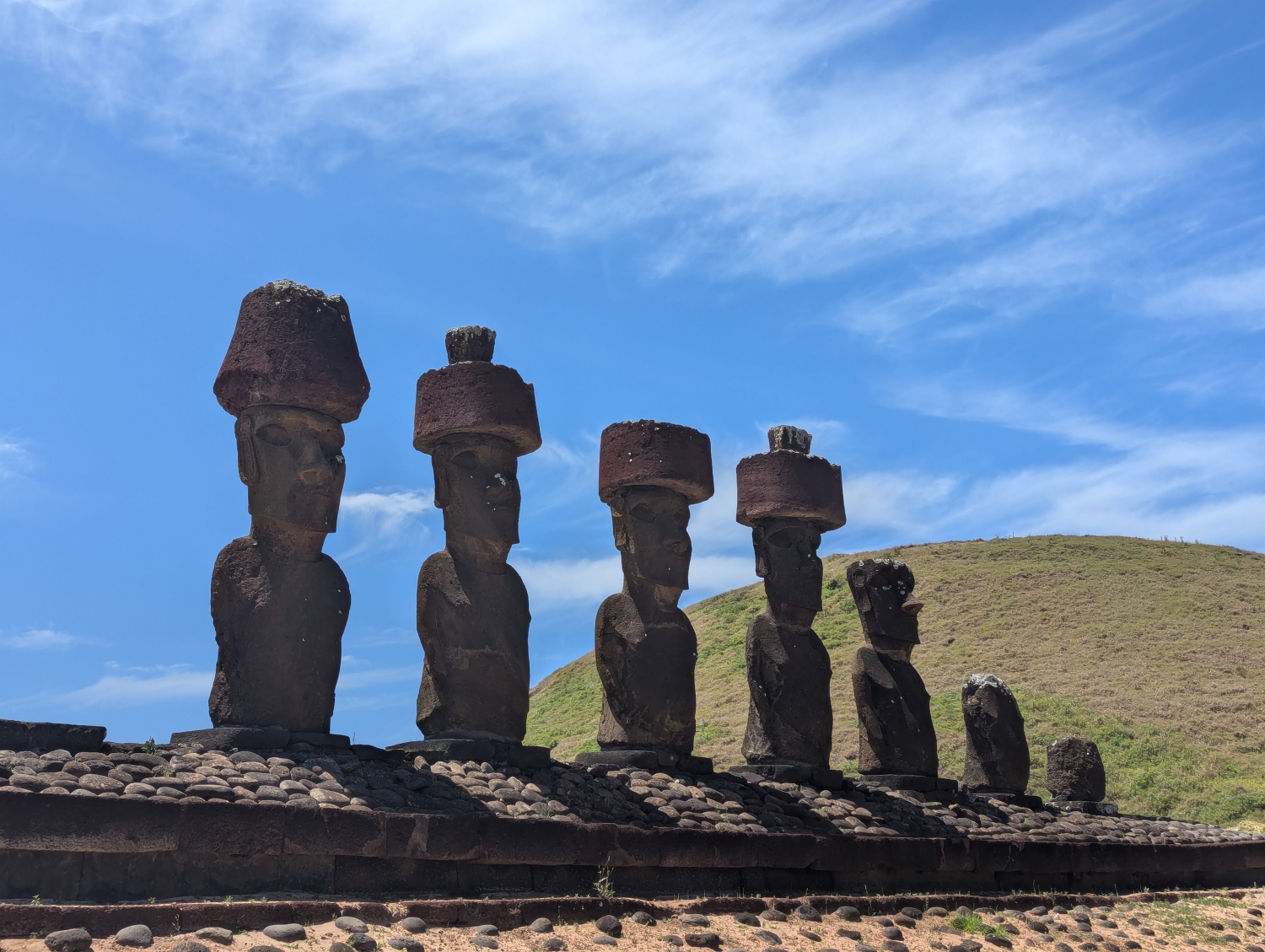
Anakena (Ahu Nau Nau)
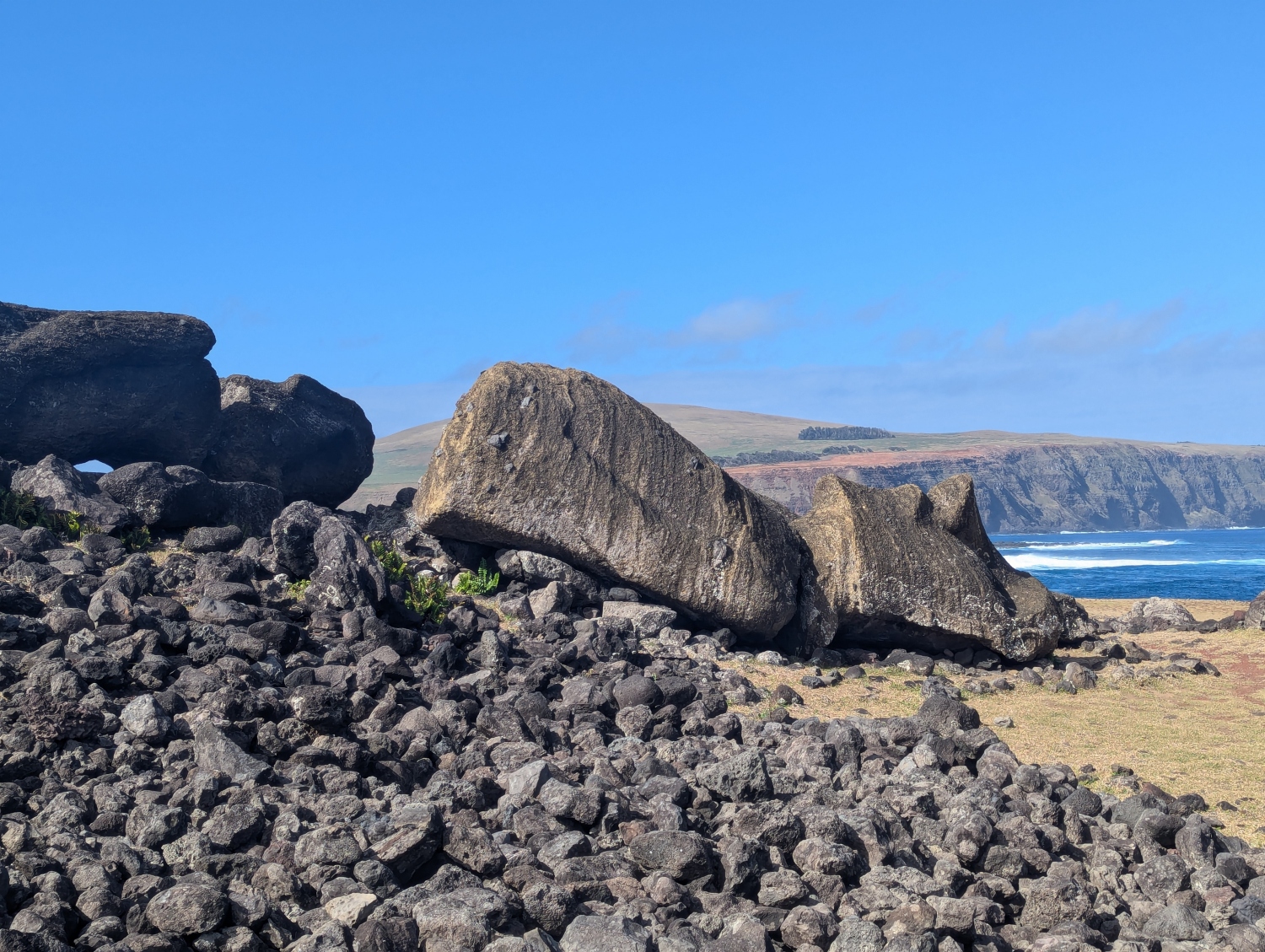
Ahu One Makihi
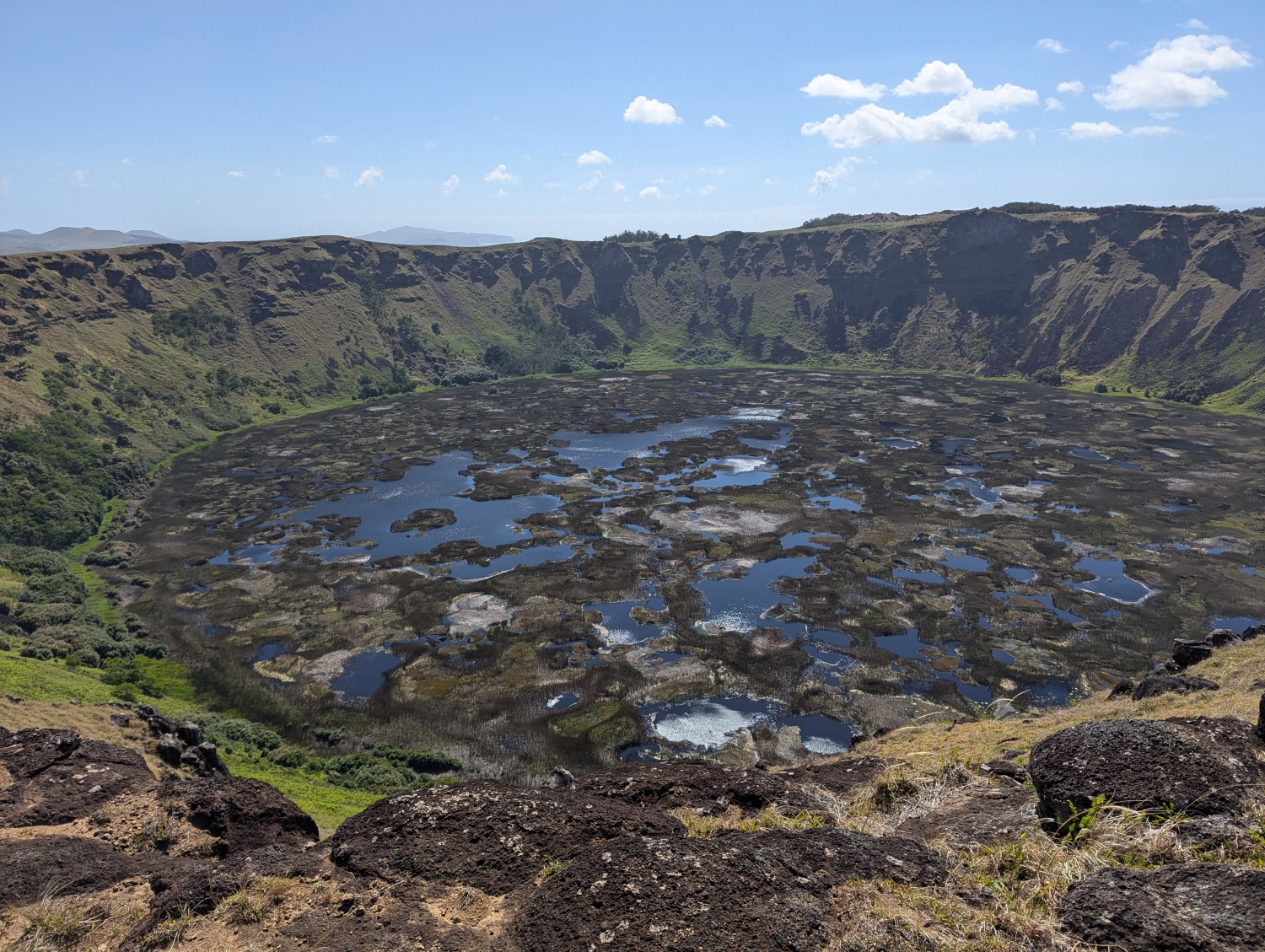
Viewpoint at Rano Kau
Outside of Rapa Nui National Park, there are other activities you can do, such as deep-sea diving, surfing, horseback riding, and more. Since we didn't try these ourselves, I can't provide any details. However, I believe they can be easily arranged on-site and usually don't require complicated planning in advance.
Moving around the island
Car rental
A car is a good choice for getting around the island quickly. When renting, keep in mind that some roads are not in great condition, and with a low-clearance car, you may have trouble reaching certain places (though a 4x4 is usually not necessary). However, most landmarks are accessible via paved roads.
There is no car insurance on Easter Island, meaning you are fully responsible for any damages. Fortunately, most cars on the island are older and often already damaged, so scratches and dents are generally not a big concern. For example, our rental car was missing a headlight. Also, don't be surprised if some rental companies require payment in cash, without a deposit or a formal paper contract.
We rented our car from Amar Pascua Rent a Car, a small family-run rental company. You can arrange everything via WhatsApp (just like most other things on the island). During our trip, we had a technical issue when the car wouldn't start, but after sending a single message, they didn't ask any questions and delivered a replacement vehicle to our location within about 15 minutes. They were very flexible and communicated well, so I can highly recommend them. We paid approximately 60 USD per day.
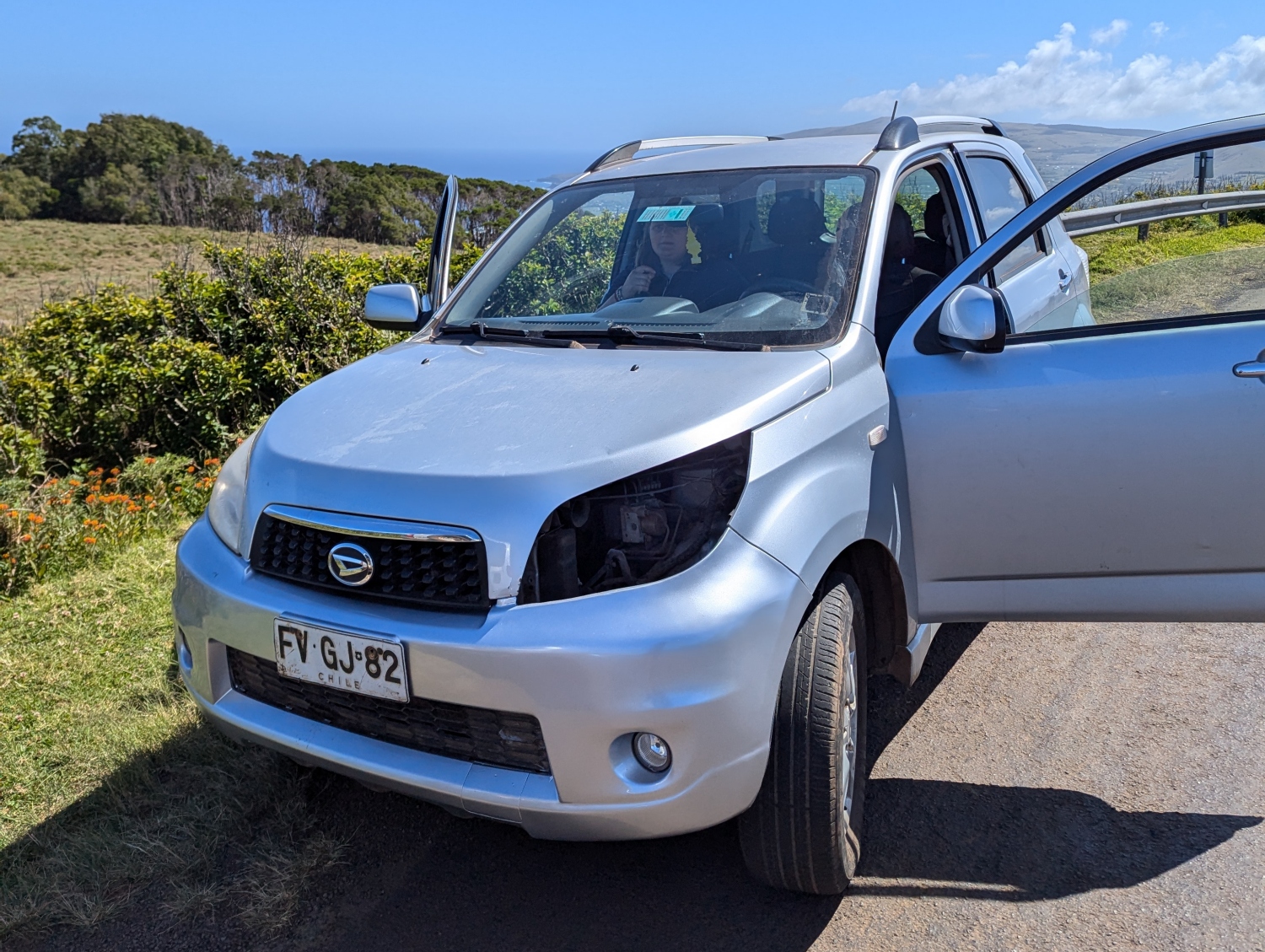
Our rented car
We didn't try other rental companies, but if you'd like, you can simply search on the map and choose one based on ratings and reviews. Given the lack of insurance on the island, I'd recommend paying extra attention to the reputation of therental company.
Some visitors rent scooters or bicycles. We don't have experience with this, so I can't provide any details. However, it probably makes sense as an alternative to a car, since the island is relatively small and most hills aren't too steep.
Taxis
Another option for getting around is taking a taxi. Taxis are usually just regular cars with nothing more than a cardboard sign reading "TAXI" in the window. Uber or similar services do not operate on the island. The easiest way to get a taxi contact is to ask a local, such as someone at your accommodation. You can negotiate the price in advance via WhatsApp.
We took a taxi, for example, to the base of Terevaka mountain, from where we hiked to the summit. The total cost for the round trip from the coast in Hanga Roa and back (after the hike) was 30 USD.
Prices and the local currency
Since Easter Island is under Chilean control, the primary currency used is the Chilean peso (CLP). If you don't have pesos on hand, you can try paying with US dollars (USD). However, most places accept credit and debit cards, including the European ones. You don't need to bring cash from Chile, as there are Santander and BancoEstado branches in Hanga Roa, where you can withdraw money from ATMs. The withdrawal fees are the same as on the Chilean mainland (5 to 8 USD).
Some travel blogs claim that prices on the island are several times higher than in mainland Chile. However, this is not really true today – prices are actually about 30 to 60% higher in both stores and restaurants. You might also come across recommendations online suggesting that you bring your own food from Chile to save money. If you have any extra space in your luggage, feel free to do that. Nevertheless, I wouldn't pay for additional baggage just for that, because it would cost more than simply buying food on the island.
In the following table, I list a few examples of prices, but please consider this as a rough estimate. Since I don't have exact data, this is based just on my observations. Prices may also vary depending on the season. The listed prices are from spring (November).
| ITEM | PRICE ~ |
|---|---|
| Traveling and services | |
| Accommodation (one night) for two persons | from 50 USD |
| Individual guide for one day | 200 USD |
| Car rental for one day | od 50 USD |
| Park entrance ticket | 78 USD |
| Taxi (1 km) | 2 USD |
| Restaurants | |
| Regular dinner | 20 USD |
| Sandwich at a fast-food place | 10 USD |
| Beer (500 ml) | 7 USD |
| Soda in a can | 3 USD |
| Bottle of wine | 20 USD |
| Espresso | 2 USD |
| Groceries | |
| Peppers (1 kg) | 5 USD |
| Avocados (1 kg) | 5 USD |
| Apples (1 kg) | 3 USD |
| Onions (1 kg) | 3 USD |
| Carrots (1 kg) | 2 USD |
| Lettuce (1 ks) | 2 USD |
| Ham (100 g) | 3 USD |
| Cheese (100 g) | 3 USD |
| Pack of 6 eggs | 2,5 USD |
| Pasta (500 g) | 1,5 USD |
| Beef (1 kg) | 15 USD |
| Beer in a can | 1,5 USD |
| Coffee (250 g) | 5 USD |
Recommended length of the stay
We spent a total of 8 days on Easter Island in early November, which I would say is above average. Upon arrival, we had a guide for the entire first day, and we spent the rest of our stay exploring on our own, visiting the places I mentioned above. The island is small, so 4 days are enough to see everything comfortably. However, be prepared to adjust your trip length based on flight prices if you don't want to pay significantly more.
Links elsewhere
As for Easter Island, I've prepared a map of places you can visit without a guide. We also have a YouTube channel Adéla a Štěpán na tripu (in Czech), where we share videos from our travels if you'd like to learn more.
Feel free to send me any comments, suggestions, or feedback at stepan@pesout.net.
